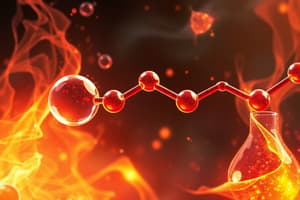Podcast
Questions and Answers
What characterizes an oxidation reaction?
What characterizes an oxidation reaction?
- Loss of oxygen atoms
- Gaining of hydrogen atoms
- Gaining of oxygen and nitrogen atoms
- Loss of hydrogen atoms or gain of oxygen atoms (correct)
What is the significance of pyridinium chlorochromate (PCC) in organic reactions?
What is the significance of pyridinium chlorochromate (PCC) in organic reactions?
- It stops oxidation at the aldehyde stage (correct)
- It fully oxidizes alcohols to carboxylic acids
- It selectively reduces aldehydes to alcohols
- It catalyzes aldol cyclization reactions
Which reagent can selectively oxidize aldehydes in the presence of other functional groups?
Which reagent can selectively oxidize aldehydes in the presence of other functional groups?
- Ag2O (correct)
- NaBH4
- PCC
- LiAlH4
Why are 5 or 6-membered rings commonly formed in intramolecular aldol reactions?
Why are 5 or 6-membered rings commonly formed in intramolecular aldol reactions?
What is the purpose of Tollen’s Test in organic chemistry?
What is the purpose of Tollen’s Test in organic chemistry?
Which metal hydrides are most commonly used to reduce carbonyl compounds?
Which metal hydrides are most commonly used to reduce carbonyl compounds?
What is the primary product of an aldol condensation?
What is the primary product of an aldol condensation?
What occurs during a keto-enol tautomerism?
What occurs during a keto-enol tautomerism?
Which statement about α-hydrogens in carbonyl compounds is true?
Which statement about α-hydrogens in carbonyl compounds is true?
What is a characteristic of mixed aldol condensation?
What is a characteristic of mixed aldol condensation?
What happens to the β-hydroxy aldehyde products of aldol addition upon heating?
What happens to the β-hydroxy aldehyde products of aldol addition upon heating?
Which type of reaction involves the substitution of α-hydrogens with halogens?
Which type of reaction involves the substitution of α-hydrogens with halogens?
What is produced when hydrogen cyanide is added to a carbonyl compound?
What is produced when hydrogen cyanide is added to a carbonyl compound?
Which reagent is primarily used for the alkylation of enolate anions?
Which reagent is primarily used for the alkylation of enolate anions?
What happens during the formation of acetals from carbonyl groups?
What happens during the formation of acetals from carbonyl groups?
Which statement is true regarding the stability of hemiacetals and ketals?
Which statement is true regarding the stability of hemiacetals and ketals?
How does oxygen's electronegativity affect the carbonyl bond?
How does oxygen's electronegativity affect the carbonyl bond?
Which catalyst is commonly used for the addition of hydrogen to carbonyl compounds?
Which catalyst is commonly used for the addition of hydrogen to carbonyl compounds?
What type of reagent is a Grignard reagent considered to be in carbonyl reactions?
What type of reagent is a Grignard reagent considered to be in carbonyl reactions?
Which of the following is true about hydration reactions of carbonyl compounds?
Which of the following is true about hydration reactions of carbonyl compounds?
Cyclic hemiacetals can form under what conditions?
Cyclic hemiacetals can form under what conditions?
Flashcards are hidden until you start studying
Study Notes
Carbonyl Reactions
- Carbonyl compounds are highly polarized due to the electronegativity of oxygen.
- The carbonyl group can undergo addition, addition-elimination, and enolization-ketolization reactions.
Carbonyl Addition Reactions
- Hydration: Addition of water to a carbonyl compound, forming a hydrate. Hydrates are unstable and can revert back to the carbonyl compound.
- Acetal Formation: Aldehydes and ketones react with alcohols to form hemiacetals and acetals. Acetals are stable and can be formed from both hemiacetals and ketals.
- Addition of Hydrogen Cyanide: HCN adds to carbonyl compounds to form cyanohydrins.
- Addition of Grignard Reagents: Grignard reagents are organometallic compounds that add to carbonyl compounds to form alcohols.
- Addition of Hydrogen: Aldehydes and ketones can be reduced to alcohols using catalytic hydrogenation with Pt, Pd, or Ni. Lithium aluminum hydride and sodium borohydride can also be used as reducing agents.
Carbonyl Addition-Elimination Reactions
- Imine and Related Compounds: Amines react with carbonyl compounds, forming imines and related compounds, involving the addition of the amine to the carbonyl followed by elimination of water.
- Oxime Formation: Hydroxylamine reacts with carbonyl compounds to form oximes.
- Hydrazone Formation: Hydrazines react with carbonyl compounds to form hydrazones.
- Ester Formation: Alcohols react with carbonyl compounds in the presence of an acid catalyst to form esters.
Enolization-Ketolization Reactions
- Keto-Enol Tautomerism: Aldehydes and ketones exist in an equilibrium mixture of two forms: the keto form and the enol form. The keto form is the most common.
- α-Hydrogen Acidity: The α-hydrogen in a carbonyl compound is more acidic than a normal hydrogen due to the electron-withdrawing effect of the carbonyl group.
- Enolate Ion Formation: A base can remove the α-hydrogen to form an enolate ion.
- Applications of Enolization-Ketolization Reactions:
- Halogenation: Aldehydes and ketones react with halogens by substitution of an α-hydrogen.
- Alkylation of Enolate Anions: Alkylation of enolate ions can be used to introduce alkyl groups at the α-position. LDA (lithium diisopropyl amide) is commonly used as a base for this reaction.
- Aldol Condensation: An aldol condensation is a nucleophilic addition of an enolate ion to another carbonyl compound. This initially forms a β-hydroxy carbonyl compound, which can be dehydrated to form an α, β-unsaturated carbonyl compound.
Oxidation-Reduction Reactions
- Oxidation: Involves gaining oxygen atoms or losing H atoms.
- Reduction: Involves gaining H atoms or losing heteroatoms like O, N, or halogens.
Oxidation Reactions
- Oxidation of Alcohols: Primary alcohols can be oxidized to aldehydes and then further oxidized to carboxylic acids. Secondary alcohols can be oxidized to ketones.
- PCC (Pyridinium Chlorochromate): PCC selectively oxidizes primary alcohols to aldehydes.
- Oxidation of Aldehydes: Aldehydes can be oxidized to carboxylic acids using mild oxidizing agents like Ag2O.
- Tollen's Test: A test for aldehydes using Ag2O. If a silver mirror forms on the container walls, oxidation has occurred.
- Oxidation of Multiple Bonds: Alkenes and alkynes can be oxidized using various reagents.
Reduction Reactions
- Catalytic Hydrogenation: Aldehydes, ketones, and carboxylic acids can be reduced to alcohols using hydrogen gas and a metal catalyst like Pt, Pd, or Ni.
- Hydride Reduction: Lithium aluminum hydride (LiAlH4) and sodium borohydride (NaBH4) are powerful reducing agents that can reduce various carbonyl compounds to alcohols.
Key Concepts
- Polarity of Carbonyl Group: The carbonyl group is highly polarized due to oxygen's electronegativity.
- Nucleophilic Attack: Many carbonyl reactions involve nucleophilic attack on the electron-deficient carbon atom.
- Tautomerism: The interconversion of keto and enol forms through proton transfer, a phenomenon known as keto-enol tautomerism.
- Enolate Ion Reactivity: Enolate ions are important intermediates in many organic reactions, including aldol condensations.
- Oxidation and Reduction: Understand the concepts of oxidation and reduction in relation to carbonyl compounds and their reactions.
Studying That Suits You
Use AI to generate personalized quizzes and flashcards to suit your learning preferences.




